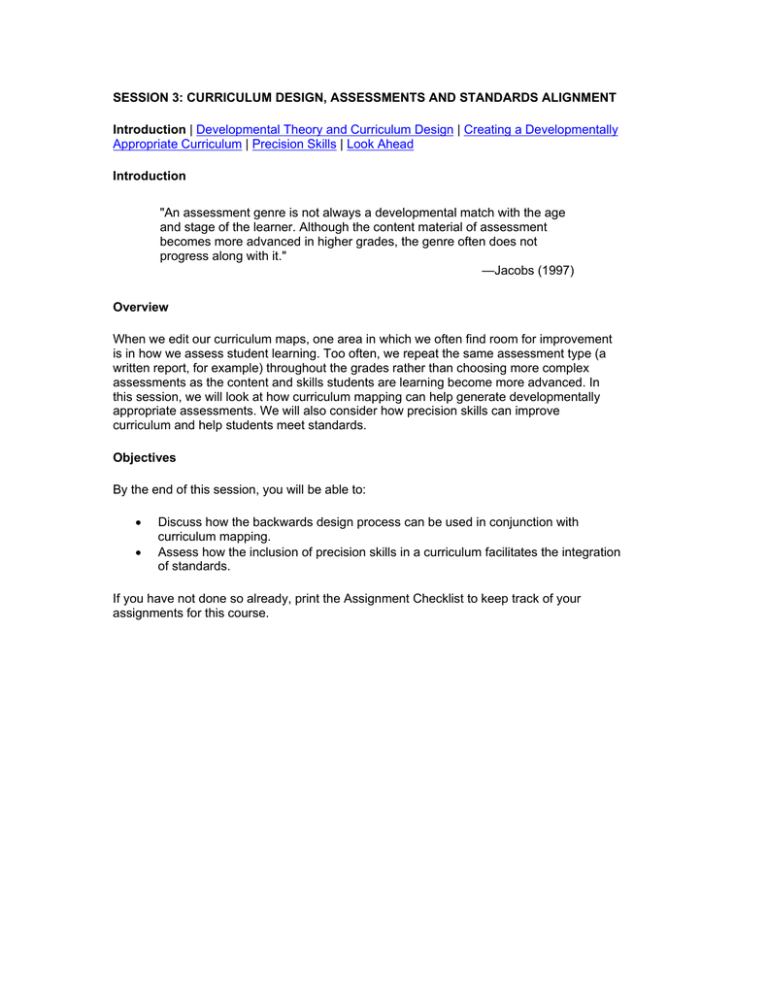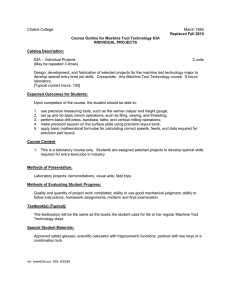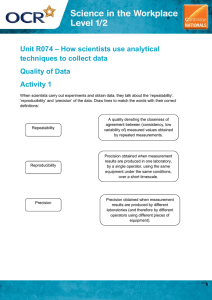
SESSION 3: CURRICULUM DESIGN, ASSESSMENTS AND STANDARDS ALIGNMENT
Introduction | Developmental Theory and Curriculum Design | Creating a Developmentally
Appropriate Curriculum | Precision Skills | Look Ahead
Introduction
"An assessment genre is not always a developmental match with the age
and stage of the learner. Although the content material of assessment
becomes more advanced in higher grades, the genre often does not
progress along with it."
—Jacobs (1997)
Overview
When we edit our curriculum maps, one area in which we often find room for improvement
is in how we assess student learning. Too often, we repeat the same assessment type (a
written report, for example) throughout the grades rather than choosing more complex
assessments as the content and skills students are learning become more advanced. In
this session, we will look at how curriculum mapping can help generate developmentally
appropriate assessments. We will also consider how precision skills can improve
curriculum and help students meet standards.
Objectives
By the end of this session, you will be able to:
•
•
Discuss how the backwards design process can be used in conjunction with
curriculum mapping.
Assess how the inclusion of precision skills in a curriculum facilitates the integration
of standards.
If you have not done so already, print the Assignment Checklist to keep track of your
assignments for this course.
SESSION 3: CURRICULUM DESIGN, ASSESSMENTS AND STANDARDS ALIGNMENT
Introduction | Developmental Theory and Curriculum Design | Creating a Developmentally
Appropriate Curriculum | Precision Skills | Look Ahead
Developmental Theory and Curriculum Design
Jean Piaget's research on childhood development has been applied to educational models
of all kinds. Piaget (1896-1980) spent his lifetime developing a model of child development
and learning known as developmental theory, based on the idea that a child's logic and
modes of thinking differs from an adult's. A child builds cognitive structures — mental
maps, schemes, and networks — for understanding and responding to physical
experiences in her environment, he argued. These structures become more complex as the
child develops, moving from instinctive reflexes to sophisticated mental activities. Piaget
identified four distinct stages of development: Sensorimotor, Preoperational, Concrete
Operational, and Formal Operational (refer to the chart "Piaget's Developmental Stages").
In all of Piaget's developmental stages, the child experiences her environment using the
mental maps she has constructed so far:
•
•
If a child has repetitive experiences, they fit into the child's cognitive structure and
the child remains comfortably within the same developmental stage.
If an experience is different or new, the child's mental equilibrium is challenged and
she must alter her cognitive structure to accommodate the new experience.
Challenging experiences compel children to move from one developmental stage
to the next.
Understanding these stages and characteristics of child development helps educators to
plan a developmentally appropriate curriculum that enhances students' conceptual growth
by prioritizing the development of cognitive structures and the experiences that play a
critical role in learning. Curriculum planners can use developmental theory as a tool to
match the skills and assessments embedded in their curriculum to the capabilities that
students have at a given stage in their development. Piaget's theory gives teachers
guidelines for planning educational experiences that encourage progression from one
developmental stage to the next.
In the video "Developmental Assessment," curriculum mapping consultant Bena Kallick
discusses assessments that reflect students' capabilities. As you view the video, consider
why Kallick's examples are developmentally appropriate.
SESSION 3: CURRICULUM DESIGN, ASSESSMENTS AND STANDARDS ALIGNMENT
Introduction | Developmental Theory and Curriculum Design | Creating a Developmentally
Appropriate Curriculum | Precision Skills | Look Ahead
Creating a Developmentally Appropriate Curriculum
As mapping expert Dr. Heidi Hayes Jacobs comments, "the greatest value of mapping
comes when teams of teachers review maps to determine the appropriate match between
the level of student learning and the type of work expected." Curriculum maps allow
teachers to look at curricula over a longer range of time, allowing them to see where they
can better place developmentally appropriate activities that are neither repetitious nor too
advanced. Thoughtful alignment of developmental characteristics and the genres of work
expected can only lead to a curriculum better suited to students' needs.
You can easily integrate a review of developmental appropriateness into the curriculum
map editing process. In Curriculum Mapping I, you learned the seven steps curriculum
mapping teams use:
1.
2.
3.
4.
5.
6.
7.
Find new information
Eliminate gaps
Eliminate repetition
Address areas for integration
Align content, skills, assessments, and standards
Address coherency issues
Focus on the timeliness of the curriculum
According to Wiggins & McTighe's (1998) theory of backward design, we must consider
what counts as evidence of understanding before designing specific learning activities.
Think about the implications of backward design on the curriculum mapping process as you
read "Thinking Like an Assessor," Chapter 5 of Understanding by Design. Then, respond to
the following pair of questions in the discussion forum:
Do you think that the backward design process regarding
assessments can be used in conjunction with curriculum mapping?
What effect do you think backward design has on the mapping
process?
As you complete the rest of the readings and assignments for this session, you should visit
the discussion forum two or three more times to read and comment on the postings of at
least two other learners. Refer to the discussion rubric to review the expectations for
participating in online discussions in this course.
SESSION 3: CURRICULUM DESIGN, ASSESSMENTS AND STANDARDS ALIGNMENT
Introduction | Developmental Theory and Curriculum Design | Creating a Developmentally
Appropriate Curriculum | Precision Skills | Look Ahead
Precision Skills
Precision skills are the building blocks of general skills. They are the ordered, cumulative
skill sets that students must master in order to become a higher-order thinker. There are
precision skills that apply within a single academic discipline. For example:
Subject
General
Skill
Precision Skills
Science
Process of
Inquiry
To observe an event in the natural world or space, to collect and
display data, to cite significant variables, to pose explanations, to
predict future results.
There are also precision skills that apply across the disciplines:
Subject
Precision Skills
Editing and revising skills, organizational skills, reading for
Core subjects: English, decoding, reading for text interaction, speaking skills in a range
science, mathematics
of forums, technology for information access, technology for
& social studies
production purposes, career habits for personal and group
work, etc.
Precision is critical to skill development. If you identify precision skills as clear-cut, active
goals instead of vague guidelines, you help students understand the steps they need to
take in order to acquire the general skills and engage them in the process of skill
development.
For example, in physical education, the coach is unlikely to say, "We're working on critical
playing skills today." She says, "We're working on driving into the basket." This is a
precision skill that students can focus on as a step toward mastering the general skill of
playing basketball. Teachers in any department can break down general skills into
precision skills. For example, instead of telling students, "We're working on critical thinking
and speaking skills today," a history teacher might say, "Today we're holding a debate. In
teams, you will debate the proposition, 'One hundred and forty years after it began,
Americans are still fighting the Civil War.'" This kind of precise skill description will help
students actively engage in skill development.
How does curriculum mapping facilitate the development of precision skills?
A curriculum map includes the skills that are embedded in a curriculum. With this data, you
can focus on breaking general skills into component precision skills. As you work with
precision skill development on a curriculum map, your goal is to identify specific areas of
concern that your students will work on over time. Precision skills should be entered into
the "Skills" area of a curriculum map in relation to the general skills.
For example, imagine that your sixth-grade students are competing in a basketball
tournament, a culminating experience in physical education. They play with enthusiasm
and excel at long shots; they falter at lay-ups. A look at the physical education curriculum
map might reveal a gap:
•
•
You spent very little time practicing lay-up shots, a critical precision skill.
You did not spend time discussing the strategy of going for a long shot versus a
lay-up shot.
This observation could be a departure point for revising the physical education curriculum
and redistributing your focus equally to lay-up shots, long shots, and strategy. These
precision skills will act as building blocks that students can use to attain the general skills.
A curriculum map helps educators link assessment data to precision skill development, as
demonstrated by the basketball example. Establishing a feedback loop between the map
and the assessment data can be done both horizontally within a single grade level, and
vertically over the course of multiple grades:
Example: Horizontal precision skill development
•
•
Observation: students under-perform on lay-up shots, a precision skill within the
general skill of ball-handling and/or playing the game.
Mapping solution: use a grade-level curriculum map to distribute your teaching
focus more evenly among all the shot types that students need to know.
Example: Vertical precision skill development
•
•
Observation: students seem generally unable to catch and handle a ball and think
strategically about shot types.
Mapping solution: use a vertical physical education curriculum map that represents
multiple prior grades to revise the teaching of ball-handling skills over time.
You can apply these same strategies to precision skill development in other disciplines. For
example, if test scores in the 8th grade classes are low, the problem could be treated
immediately using the 8th grade curriculum map, and more systemically using a map that
represents student curriculum from kindergarten through 8th grade.
See the two versions of the excerpted Grade 1 Mathematics maps below for an example of
how one teacher revised a map to include precision skills. Use the Notes section of your
online journal to record your observations.
Grade 1 Mathematics without precision skills
Grade 1 Mathematics edited to include precision skills
Consider the relationship between precision skills and standards. Respond to the following
questions in your online journal:
How does including precision skills in your curriculum map facilitate
the integration of standards?
Refer to the online journal rubric for expectations in completing journal entries.
Return to your online journal. Be sure that all of your responses are complete and free of
grammatical and structural errors. Your facilitator will assess your journal reflections at the
end of this session.
Additional Resources (not required)
Jacobs, H. (1997). Using mapping to generate developmental assessment. In Mapping the
Big Picture: Integrating Curriculum & Assessment K-12 (35-40). Alexandria, VA:
Association for Supervision and Curriculum Development.
Wiggins, G. & McTighe, J. (1998). What is backward design? In Understanding By Design
(7-19). Alexandria, VA: Association for Supervision and Curriculum Development.
Citation
Jacobs, H. (1997). Mapping the Big Picture: Integrating Curriculum & Assessment K-12
(36). Alexandria, VA: Association for Supervision and Curriculum Development.
Resources
Wiggins, G. & McTighe, J. (1998). Thinking like an assessor. In Understanding By Design
(63-84). Alexandria, VA: Association for Supervision and Curriculum Development.
Kelly, M. (Producer). (2001). Developmental assessment. [Video clip]. In Curriculum
Mapping: The Bronxville School. New York: Thirteen/WNET.
SESSION 3: CURRICULUM DESIGN, ASSESSMENTS AND STANDARDS ALIGNMENT
Introduction | Developmental Theory and Curriculum Design | Creating a Developmentally
Appropriate Curriculum | Precision Skills | Look Ahead
Look Ahead
In Session 4, you will learn strategies for spreading curriculum mapping beyond the school
building to the district level. You will also continue work on your final project for this course.
Remember, for this project you will need the curriculum map you created in "Curriculum
Mapping I" and revised in Session 2 of this course. Review the final project and final project
rubric once again. Make notes to guide you.
© 2005 PBS. All rights reserved.





